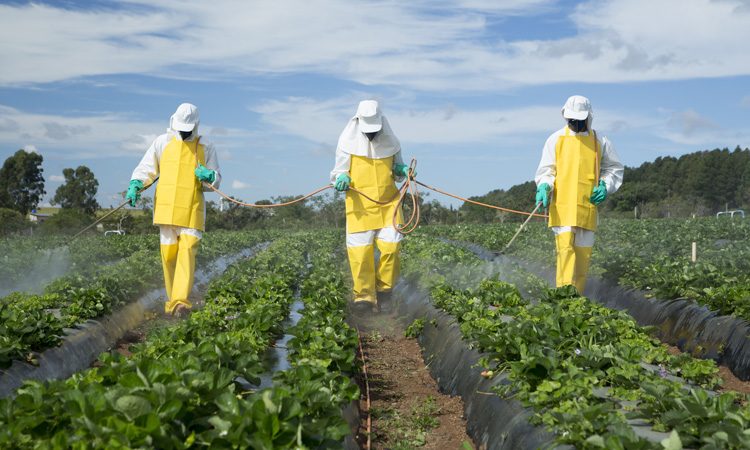Chlorpyrifos: The Next “Glyphosate”?
- Like
- Digg
- Del
- Tumblr
- VKontakte
- Buffer
- Love This
- Odnoklassniki
- Meneame
- Blogger
- Amazon
- Yahoo Mail
- Gmail
- AOL
- Newsvine
- HackerNews
- Evernote
- MySpace
- Mail.ru
- Viadeo
- Line
- Comments
- Yummly
- SMS
- Viber
- Telegram
- Subscribe
- Skype
- Facebook Messenger
- Kakao
- LiveJournal
- Yammer
- Edgar
- Fintel
- Mix
- Instapaper
- Copy Link
Posted: 10 September 2019 | Jaclyn Bowen | No comments yet
Jaclyn Bowen from Clean Label Project explores the use of chlorpyrifos as a pesticide and the potential health risks involved.


Glyphosate, the active ingredient in RoundUp, is a widely used herbicide that controls broadleaf weeds and grasses. It has been registered as a pesticide in the US since 1974.1 However, in recent years glyphosate has come under increased scrutiny because of its designation under the World Health Organization (WHO) as being a “probable carcinogen.”2
In May 2019, a California jury awarded more than $2 billion to a couple who claimed Bayer AG’s glyphosate-based Roundup weed killer caused their cancer – the largest US jury verdict to date against the company in litigation over the chemical.3
While it now looks like the settlement amount may be reduced, it does little to alleviate the legal crisis for Bayer, which acquired Monsanto and its Roundup brand for $63 bn in June, as it also inherited the company’s lawsuits ( more than 13,000 cases).4
The glyphosate media crisis doesn’t stop on America’s shores. On September 4th 2019, Germany indicated that it would phase out the controversial pesticide by 2023.5
Watching the regulatory, legal and consumer battle of glyphosate, and the disconnect between what is permitted in the court of law versus the court of public opinion begs the question, “what’s next?” Are there other pesticides bearing the same potential public health and consumer trust risks?
Chlorpyrifos is an organophosphate insecticide, acaricide and miticide used primarily to control foliage and soil-borne insect pests on a variety of food and feed crops.6 In August 2019, the European Food Safety Authority said that no safe exposure level can be set for the pesticide chlorpyrifos. This announcement suggests that the European Union is unlikely to allow chlorpyrifos use after its approval expires in January.7 This conflicts with the controversial action recently taken by the US Environmental Protection Agency in July 2019 clarifying that it would not ban chlorpyrifos which has been linked to health problems in children.8
Meanwhile, US consumer advocacy organisation, EarthJustice9, has been campaigning for years to ban chlorpyrifos because of its links to lower birth weight, reduced IQ, loss of working memory, attention disorders, and delayed motor development in children. The Environmental Protection Agency (EPA) revised the human health assessment of chlorpyrifos in November 2016, confirming that there are no safe uses for the pesticide serves as additional fodder for the concern.10
Variability in regulatory interpretation? Check. Risk to public and environmental health? Check. Increased consumer awareness? Check. Riddled with scandal? Check.
Given the above, all signs point to that this has the making of a pesticide of significant risk to brand and consumer trust. Want to gauge your brand risk? Get tested by an accredited analytical chemistry laboratory. But approach testing laboratories with a critical eye. Some have poor levels of detection and levels of quantification that can give brands a false sense of comfort and security. Look for analytical laboratories that can conduct multiple pesticide analyses and confidently get results into the single digit parts per billion.
References
2 https://www.who.int/foodsafety/faq/en/
3 https://www.washingtonpost.com/…
4 https://www.washingtonpost.com….
About the Author
Jaclyn Bowen MPH, MS is the Executive Director of Clean Label Project and a food safety and quality systems engineer. Prior to coming to Clean Label Project, she spent 15 years at the World Health Organization Collaborating Centre, NSF International, working on the creation and enforcement of food safety and water quality standards and compliance systems.
Related topics
Clean Label, Food Safety, Health & Nutrition, Pesticides, Regulation & Legislation









